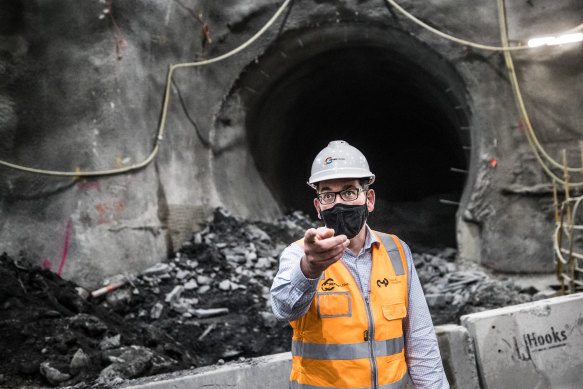This was published 3 years ago
Watchdog slams lack of plan amid ‘unprecedented’ transport spending
By Timna Jacks
Victoria’s financial watchdog has slammed the government for failing to come up with an overall vision for the state’s transport network amid unprecedented spending on road and rail projects.
The state’s transport department is required by law to create a comprehensive plan for the network that covers all areas of travel – roads, rail, freight, walking and cycling paths – to ensure they work together.

Premier Daniel Andrews at the State Library station, part of the Metro Tunnel project, in November.Credit: Jason South
But the Department of Transport and its predecessors going back a decade have failed to comply with the Transport Integration Act 2010, described in Parliament when it was introduced as a “watershed in the evolution of transport policy”.
A new probe by the Victorian Auditor-General reveals multibillion-dollar projects are being built on the back of fragmented planning. The watchdog describes a string of separate and secretive documents that have been created over nine years without any reference to each other, the act or any overarching goal for the state transport network.
This is despite seven years of advice from external consultants who have “clearly and repeatedly” warned the department about the absence of a plan and the act’s requirements, the watchdog stated in its report tabled in Parliament on Wednesday.
Department of Transport secretary Paul Younis rejected some of the watchdog’s recommendations, arguing the department did in fact have a transport plan and its 40 separate strategies met the requirements of the act.
But acting Auditor-General Dave Barry said this claim “does not withstand scrutiny”.
“The documents [the Department of Transport] identifies as comprising the transport plan do not fully meet legislative requirements. This collection of documents does not provide a coherent and comprehensive transport plan,” Mr Barry said.
“The absence of a transport plan as required by the act, during a decade of unprecedented investment in transport infrastructure, creates risks of missed opportunities to sequence and optimise the benefits of these investments to best meet Victoria’s transport needs.”
Mr Barry found that while the state’s transport plan is supposed to be publicly accessible, only 14 of the department’s 29 plans have been published.
Under the act, the plan should be formed after consultation with stakeholders, including transport system users and members of the community, government agencies and the private sector, but this has not been done.
Planners have repeatedly called for an integrated transport plan in the wake of an $87 billion “Big Build” agenda that has almost doubled in size since Premier Daniel Andrews took power in 2014, growing to nearly 90 major projects.
RMIT Centre for Urban Research director Jago Dodson said the report was a “stunning indictment of the ‘build first, ask questions later’ approach to transport planning that has prevailed in Victoria for nearly a decade. The failure is most apparent in the announcements of multibillion-dollar projects, like the Suburban Rail Loop, North East Link or Airport Rail, without a plan.
“We have no clear way of understanding how these vastly expensive schemes address Melbourne’s overarching transport goals, what the alternatives are, or what cheaper non-infrastructure options could have been adopted.”
Opposition transport infrastructure spokesman David Davis said the lack of a plan has left Labor’s major projects “having all the appearance of a dog’s breakfast”.
“Daniel Andrews and Jacinta Allan are officially on a frolic with tens of billions of dollars of Victorian taxpayers’ money, wasting eye-watering amounts of our hard-earned cash on unplanned and unintegrated transport infrastructure projects,” he said.
Victorian Greens transport spokesman Sam Hibbins said transport planning in the state was a “secretive mess”. In late 2019 the Greens moved an amendment that would have compelled the government to table its transport plan, which was blocked by Labor and crossbenchers.
“Our tram network remains largely inaccessible to people with disability, and the government’s mega toll roads are environmental and financial disasters, with transport now the fastest-growing source of carbon emissions,” Mr Hibbins said.
“The reality is people are still waiting 20 minutes for a train and an hour for their local bus, and face unsafe bike routes and pedestrian crossings in their communities.”
Minister for Transport Infrastructure Jacinta Allan countered this, pointing to “165 integrated road and rail projects that are currently under way across Victoria that will improve road transport, public transport and freight. Any Victorian travelling on our roads or rail network can see our state’s integrated transport plan coming to life – Victoria’s Big Build.
“Our plan also supports over 50,000 jobs – the only alternative announced by the Victorian Liberals is to cut infrastructure funding, putting these jobs at risk and grinding the city to a halt.”
The Morning Edition newsletter is our guide to the day’s most important and interesting stories, analysis and insights. Sign up here.